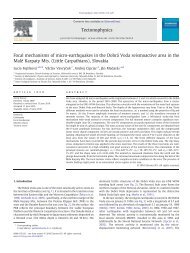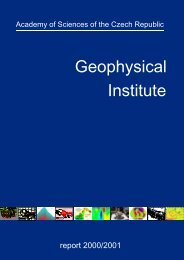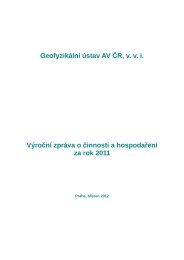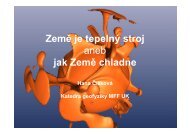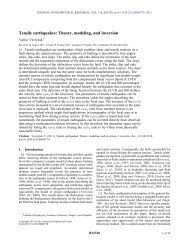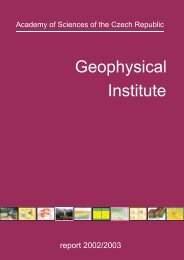Geophysical Institute of the ASCR
Geophysical Institute of the ASCR
Geophysical Institute of the ASCR
You also want an ePaper? Increase the reach of your titles
YUMPU automatically turns print PDFs into web optimized ePapers that Google loves.
Fig. 33. Model <strong>of</strong> <strong>the</strong> conductance across <strong>the</strong> Carpathian region along with a pattern <strong>of</strong> principal fault zones at<br />
<strong>the</strong> transition zone between <strong>the</strong> Bohemian Massif and <strong>the</strong> West Carpathians. The conductance distribution<br />
results from a minimum gradient support focussing employed within <strong>the</strong> thin sheet minimization algorithm.<br />
Long-period geomagnetic induction data within <strong>the</strong> range <strong>of</strong> hundreds to thousands <strong>of</strong> seconds<br />
represent a significant source <strong>of</strong> information with regard to <strong>the</strong> lateral electrical differentiation <strong>of</strong> <strong>the</strong><br />
earth’s crust on a scale <strong>of</strong> first-order geological and tectonic units. Our earlier model studies into <strong>the</strong><br />
lateral distribution <strong>of</strong> <strong>the</strong> crustal conductance in <strong>the</strong> West Carpathians have been newly extended to<br />
encompass also <strong>the</strong> Ukrainian segment <strong>of</strong> <strong>the</strong> Carpathians. The magnetic variation data in <strong>the</strong> period<br />
range <strong>of</strong> 1000 to 6000 s recorded at 172 sites situated in <strong>the</strong> eastern part <strong>of</strong> <strong>the</strong> Czech Republic and in<br />
<strong>the</strong> Polish, Slovakian and Ukrainian Carpathians were used as inputs for <strong>the</strong> modelling <strong>of</strong> <strong>the</strong><br />
conductance distribution within <strong>the</strong> Carpathian region (Fig. 33). An original linearized algorithm for<br />
<strong>the</strong> inversion <strong>of</strong> <strong>the</strong> geomagnetic induction data for <strong>the</strong> conductance distribution in a unimodal thin<br />
sheet has been applied to <strong>the</strong> collection <strong>of</strong> <strong>the</strong> geomagnetic transfer functions available, and several<br />
regularization approaches, both quadratic and non-smooth, have been tested in <strong>the</strong> inverse procedure<br />
so as to spatially focus zones <strong>of</strong> <strong>the</strong> anomalous conductance as much as possible as well as to<br />
minimize effects <strong>of</strong> spurious anomalies with only a weak effect on <strong>the</strong> experimental data.<br />
Models <strong>of</strong> <strong>the</strong> integrated conductivity within <strong>the</strong> thin sheet indicate an anomalous belt corresponding<br />
to <strong>the</strong> Carpathian conductivity anomaly in its western, nor<strong>the</strong>rn and eastern part and confirm a quasilinear<br />
character <strong>of</strong> <strong>the</strong> anomaly. The conductance models also suggest an alternative interpretation <strong>of</strong><br />
<strong>the</strong> electrical nature <strong>of</strong> <strong>the</strong> contact <strong>of</strong> <strong>the</strong> Carpathian plate with Paleozoic structures in <strong>the</strong> west.<br />
Contrary to earlier models that explained <strong>the</strong> anomalous pattern <strong>of</strong> <strong>the</strong> induction arrows above <strong>the</strong><br />
eastern margin <strong>of</strong> <strong>the</strong> Hercynides as a joint effect <strong>of</strong> a quasi-linear zone <strong>of</strong> anomalously high<br />
electrical conductivity and a hypo<strong>the</strong>tical extensive crustal conductor situated beneath SW Poland,<br />
well outside <strong>the</strong> data coverage domain, <strong>the</strong> present image ra<strong>the</strong>r suggests that this anomaly may be<br />
due to several conductive belts intersecting <strong>the</strong> anomalous zone. These belts follow faults, dividing<br />
<strong>the</strong> transition zone between <strong>the</strong> Bohemian Massif and <strong>the</strong> West Carpathians into individual blocks<br />
formed by metamorphic and plutonic complexes. In <strong>the</strong>se zones material from <strong>the</strong> deep layers <strong>of</strong> <strong>the</strong><br />
crust might have penetrated and generated domains <strong>of</strong> <strong>the</strong> increased crustal conductivity (Kováčiková<br />
et al., 2005).<br />
Interestingly, <strong>the</strong> above interpretation <strong>of</strong> <strong>the</strong> anomalous induction at <strong>the</strong> eastern margin <strong>of</strong> <strong>the</strong><br />
Bohemian Massif closely resembles one <strong>of</strong> our recent methodological results obtained from <strong>the</strong><br />
analysis <strong>of</strong> effects caused by <strong>the</strong> electrical anisotropy in laterally non-uniform conductors.<br />
Specifically, 2-D structures with oblique electrical anisotropy with respect to <strong>the</strong> structural strike and<br />
49




